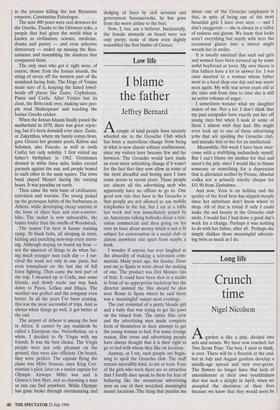Long life
Crunch time
Nigel Nicolson
Agarden is like a play, divided into acts and scenes. We have now reached Act Two Scene Four. The best, I used to think, is over. There will be a flourish at the end, but in July and August gardens develop a middle-age spread and turn ever-green. The flowers no longer have that look of astonishment at their own youthfulness that was such a delight in April, when we accepted the shortness of their lives because we knew that they would soon be replaced by something even lovelier, the tulip, the iris and the rose. But when these too die, we mourn the impermanence of a garden in contrast to the slow cycle of nature beyond its boundaries, the crops and trees that never seem to lose their dig- nity.
So year after year I would lament that when Wimbledon is over, the garden is over. The columbines were the test. These lovely, impertinent little flowers, some with tails like a rocket, some with faces so cheerful that you smile back at them, all with unexpected combinations of pattern and colour created by their tendency to hybridise among themselves ('their morals leave much to be desired', a witty nursery- man has said), would riot all through June, and then came the moment when their tan- gled debris must be swept away. Act One was over. Then the roses took centre-stage, for about three weeks at fullest stretch, for they flowered so generously at the start that soon they had nothing left to give. This year my melancholy at the approach of August is diminished because I notice more. Our garden is one that needs to be sipped, not gulped. Just as it is more rewarding to spend an hour in a single room of the National Gallery than walk through the whole of it in two, so by focussing attention on one part of the gar- den at a time, I have found flowers that I never knew existed. I have before me two such discoveries. One is almost the last rose of summer, 'Souvenir du Docteur Jamain', a sweetly scented, tightly folded, deep-vermilion hybrid perpetual which my mother rediscovered in a derelict garden in Somerset. The other is the white Veronica, virginica 'alba', which sports a central spire supported at its base by branching sprays and saw-toothed leaves. This is the way, I find, to fall in love with flowers, to disclose them hiding behind the lush foliage of other plants and then place a single perfect specimen within a few inches of my nose.
I like perfection in flowers. I like roses to be regularly dead-headed, just as I hate to see plates left unwashed, and I look for- ward to the day when the clippers will begin to shave the hirsute yews. I prefer the formality of Lutyens to the exuberance of Jekyll, and our garden owes much to both.
But I am warned that there can be too much tidiness. My annual, and only, con- test with our National Trust gardeners is how long to leave the orchard unmown. In spring it is a delight, a blaze of daffodils and narcissus. In early summer wild flowers spangle the lengthening grass. The crunch comes about 25 June, when to my eyes the orchard looks too rank to form part of a garden, but it is argued that it should be left uncut till the end of July, to allow time for the seeds of the wild flowers to drop. 'Never mind!', I cry. 'Buy more seed from a merchant and scatter them!' It is an argu- ment that I invariably lose, the defeat of the classical temperament by the romantic.



















































 Previous page
Previous page